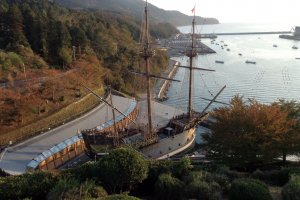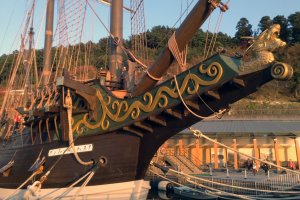On October 28th, 1613 the Sant Juan Bautista raised anchor from a small harbor just outside Sendai in modern day Miyagi Prefecture to embark on a historic mission which would have its adventurers travel all the way to Rome. It was the age of discovery. Foreigners were coming to Japan as traders, missionaries, and explorers. A lot was happening when the country was still open to foreign people, their possessions, and their ideas. Just a few decades later the country would start its policy of world isolation, albeit a small island off Nagasaki known as Dejima. As a matter of fact though, this outside interaction was primarily taking place in western Japan. The samurai lord Date Masamune of the capital Sendai had other plans when he envisioned the creation of a European style ship to set sail from the north.
The Sant Juan Bautista was a ship with a mission. Date Masamune selected Hasekura Tsunenaga, a somewhat novice retainer of his, to establish trade with Mexico. More specifically, the Keicho Mission as it was coined was to establish friendly relations with the Spanish colony in Mexico. To accomplish this, Tsunenaga and his company would need to receive permission from the King of Spain and permission from the Pope in Rome. Part of the deal in being granted trade with Mexico was for Date Masamune to allow and encourage the spread of Christianity in his domain. Tsunenaga was baptized in Rome, but it is still debated whether Masamune was truly interested in Christianity or just trade. Seven years after his departure and failing at negotiations abroad, Tsunenaga returned to a Japan that now persecuted Christians. While the mission never accomplished its intended goals, the mission is remembered for its incredible journey and historical significance through cultural exchange. You can learn all about the Keicho Mission and experience the ship that began and ended the mission at the Sant Juan Bautista Museum in Ishinomaki City.
The main attraction at the museum is a full-scale replica of the Sant Juan Bautista. Sitting idle in its own personal harbor, the ship is an impressive site. With a length of 55 meters and height of 48 meters, it was sturdily built to endure the rampant storms found throughout the Pacific Ocean. Step on board and you are taken back four centuries. See artifacts and manikins placed throughout the ship to learn what life was like on the open sea. Pamphlets are available around information and service areas, though most of the need to know information is written in Japanese and English on the ship. While the Keicho Mission itself went all the way to Rome and back, the Sant Juan Bautista was utilized in the 90 day voyage to Mexico. The ship is more spacious inside then first appears, yet that image vanishes quickly when you learn that 180 people had crammed aboard. From Mexico the mission headed to Spain and eventually Rome. Meanwhile the Sant Juan Bautista returned to Japan, only to be summoned again to Mexico seven years later to escort Tsunenaga back to his homeland. The returning party stopped briefly in the Philippines where the Sant Juan Bautista was sold to the Spanish armada, but soon after disappeared from the history books. Tsunenaga made it back to Japan on another ship then died two years later from disease.
The Sant Juan Bautista Museum also features a video viewing room, ship simulation attraction, small exhibitions inside the main building, and a small gift shop. The facility reopened in November 2013 after more than two years of intensive restoration work caused by tsunami damage.


































